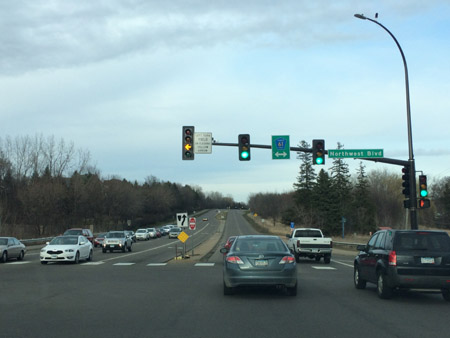Featured Content
Flashing Yellow Arrows: Reducing Delay & Improving Safety
APRIL 26, 2016
By Scott Poska, SRF Consulting Group, Inc.
“I can see there is no oncoming traffic, so why do I have to sit here and wait for a green left turn arrow?” Everyone has experienced this frustration and unnecessary delay at signalized intersections across Minnesota. However, traffic engineers have a new tool in the toolbox to combat these issues and increase safety: the flashing yellow arrow signal indication.
Flashing Yellow Arrow (FYA) left-turn signal indications have exploded in popularity since their adoption into the Manual on Uniform Traffic Control Devices as a standard treatment in 2009. Flashing yellow arrow indications can be a very cost-effective way to have an immediate impact -- in terms of delay and safety -- to drivers in a community.

Their greatest benefit is that left turn phasing can be varied by time of day to respond to varying traffic demands, which reduces delay. For example, permissive-only phasing (flashing yellow left-turn arrows are displayed) can be used during low volume off-peak times such as overnight periods. Protected only phasing (only green left turn arrows are displayed) can be used during higher volume peak times such as morning and evening rush hour periods. According to the National Cooperative Highway Research Program Report 493, having dedicated left arrow indications for left turning movements is better understood and obeyed by the driving public, leading to fewer crashes.
“Why doesn’t this intersection have flashing yellow arrows?” Agencies that own and operate traffic signals frequently get requests or suggestions like this from drivers. However, many agencies have time, resource, and expertise limitations to evaluate the feasibility and benefits of flashing yellow arrow indications and implement them.
For example, the City of Plymouth recently commissioned SRF Consulting Group to conduct a traffic study of 70 signalized intersections within the city to evaluate the feasibility and prioritize the implementation of flashing yellow arrows. The study required a three-step approach.
The first step included a comprehensive data collection effort that was coordinated across multiple agencies that own and operate traffic signals (55 percent Hennepin County; 30 percent MnDOT; and 15 percent City of Plymouth) within the city. This included a site visit to each intersection to inventory FYA-compatible components. Each intersection was assessed by movement and evaluated for feasibility of FYA, both from a geometric standpoint (lane use and sight distance limitations) and a safety standpoint (crash history review). Of the 70 study intersections, 57 intersections (81 percent) had at least one movement that was FYA eligible.
For the second step of the process, movements that passed the initial screening were evaluated using criteria to estimate the amount of benefit to the intersection and assigned a relative benefit score. Cost estimates for planning-level signal revision construction were prepared for each intersection that had FYA eligible movements. A method was then developed to rank each intersection based on cost and potential benefit. In the final step of the study, a three-year phasing plan for implementation was developed based on intersection rankings, geographical areas of the city, and the city’s allocated Capital Improvement Program funds per year for the FYA retrofit project.
As of April 4, 2016, 17 of the 57 intersections slated for FYA operation have been implemented in Plymouth. These intersections are experiencing reduced delays and improved levels of safety.
Jim Renneberg, Plymouth city engineer, said, “SRF exceeded our expectations with the Flashing Yellow Arrow Study. SRF staff was professional, knowledgeable, and thorough in determining which intersections to retrofit with flashing yellow arrows and a phasing plan throughout the city.”
“What times of the day should flashing yellow arrows operate?” Agencies that have intersections with flashing yellow arrows are facing a challenge in determining periods during the day when it is safe to operate flashing yellow arrows. This topic has been the subject of several research projects, including the recently completed, “Development of Guidelines for Permitted Left-Turn Phasing Using Flashing Yellow Arrows,” which was sponsored by the Minnesota Local Road Research Board (LRRB), University of Minnesota, and the Minnesota Department of Transportation. These guidelines are based on estimates of left-turn crash occurrence, intersection approach characteristics, turning movement counts, speed limits, turn protection, and sight distances at a given intersection. The research team developed a statistical model and embedded it within a spreadsheet tool (available at lrrb.org). The output of the tool is a measurement of relative risk, which relates the risk of occurrence of a left-turn crash in a given hour of the day to the traffic and other conditions prevailing during that hour at a given intersection.
The success of the flashing yellow arrow signal indication locally and nationally has proved that it is one of the most effective tools in the traffic engineer’s toolbox.
Scott Poska is with SRF Consulting Group, Inc. Email: sposka@srfconsulting.com.
What's New
-

Young Professionals Spotlight
March 25, 2024
-

APWA-MN Education Programs
March 25, 2024
-
Apply for the Young Professionals Stipend: Attend PWX Atlanta
February 23, 2024



